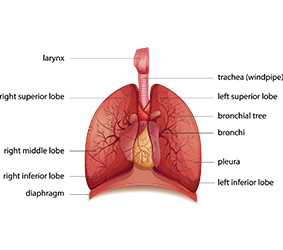There are several things you can do to lower your risk of lung cancer:
Do Not Smoke
The more you smoke and the longer you smoke, the greater your risk is for lung cancer. Smoking is linked to many types of cancer and other diseases. There is no safe kind of tobacco product and no safe amount of smoking.
It’s never too late to benefit from becoming smoke-free. If you are already someone who doesn’t smoke, keep yourself safe by avoiding exposure to other people’s tobacco smoke (second-hand smoke).
It may take several tries to quit smoking. If you’ve tried to quit in the past and have started smoking again, don’t give up. Each time you try to quit, you get closer to your goal of being smoke-free forever.
To find information on how to quit smoking visit:
Protect Yourself from Cancer-Causing Substances
In your environment
There are many things in the air that you can’t see or smell that may damage your lungs and increase your chance of lung cancer:
- Air pollution (e.g., from vehicle exhaust, industrial plants and home heating)
- Radon gas, a colourless, odourless, naturally occurring gas that can be a health risk if it builds up in a home or building. Visit Health Canada to find out what to do if you are concerned about radon gas in your home.
- Asbestos, a type of minerals used in some products like brake pads and cement. It can become harmful when disturbed or damaged, releasing fibres into the air, such as during a renovation. Visit Government of Canada to learn more about asbestos, its health risks and how to avoid exposure.
At work
If you work in certain industries, you may be exposed to metals, dust, fibres, asbestos, arsenic, radiation, gases or other compounds that may increase the risk of lung cancer. Exposure to cancer-causing substances can also vary based on how close you work to these substances. For instance, it depends on how long you’ve worked there, the exposure controls in place, and whether you’ve been using protective clothing and devices such as respirators and gloves.
You may be at increased risk for lung cancer if you are involved with:
- painting
- iron or steel founding
- rubber manufacturing
- coke ovens
- coal gasification
- nickel or aluminum smelting
- mining
- demolition
- construction
- welding
- transportation
- X-ray and gamma radiation
To protect yourself, talk to your supervisor, health or safety specialist, industrial hygienist or local union representative about exposures in your workplace.
For more information about causes of lung cancer in the workplace, visit the Occupational Cancer Research Centre’s page on lung cancer.
Eat a Healthy Diet
Eating a diet rich in vegetables and, in particular, fruit may help to reduce your risk of lung cancer. The exact reasons are not yet clear. Vegetables and fruit are good sources of beneficial nutrients such as antioxidants, carotenoids and phytochemicals that help to boost the immune system.
Know Your Personal Risks
There is some evidence that having a parent, sibling or child with lung cancer is associated with an increased risk. Some of the risk may be because family members share behaviours, like smoking or being exposed to second-hand smoke.
So far, no specific gene has been found for lung cancer. Researchers are still studying whether a genetic mutation for lung cancer can be inherited.

